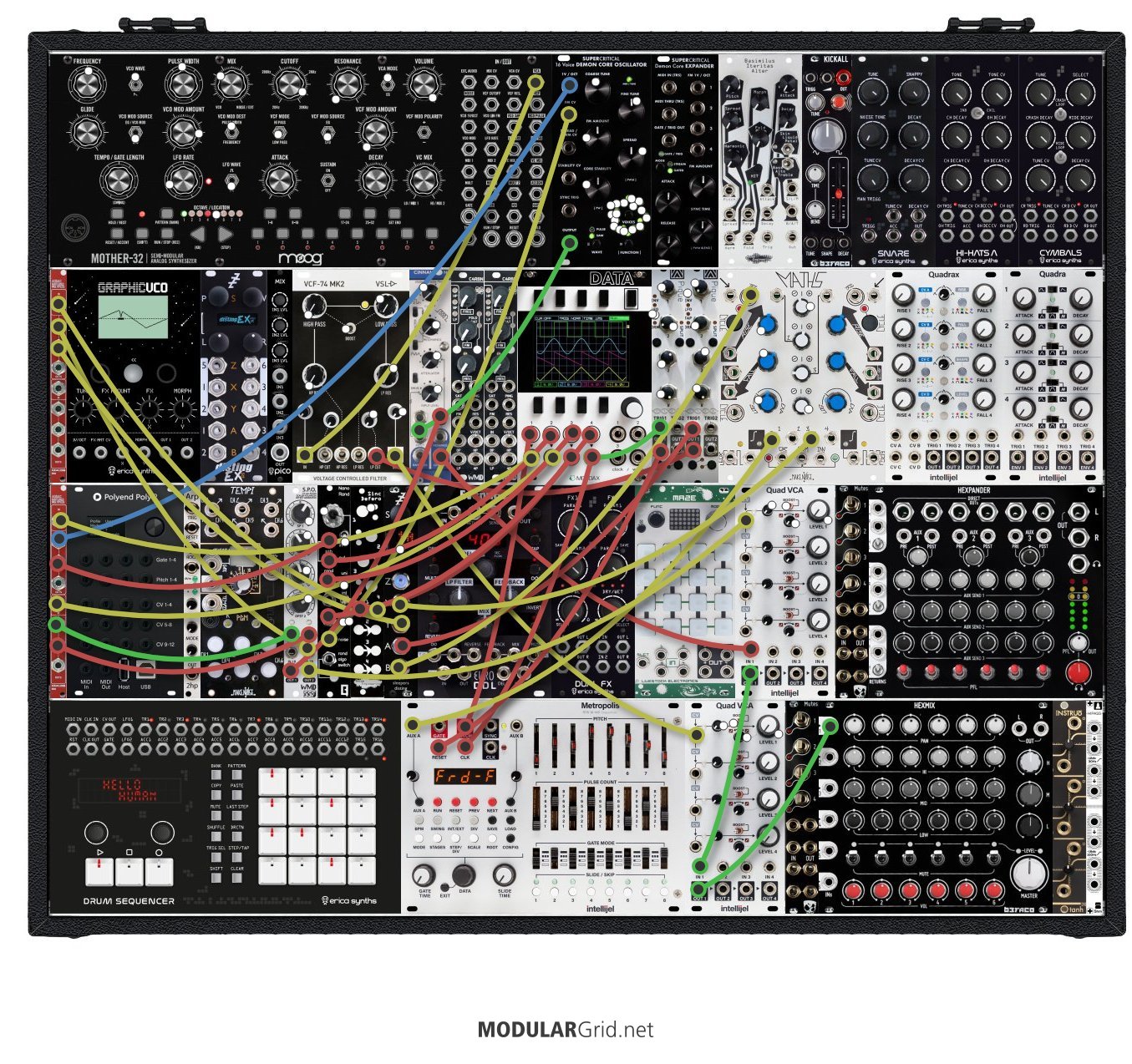OVERVIEW
This patch aims to make full use of all 4 available outputs on the Nano Rand (Teal - Random Voltage Algorithm), with each of these being sent to 1 or 2 destinations, colour-coded to match trace lines on DATA for easy identification and signal monitoring.
GREEN - Originates from the Metropolis' Pitch output
BLUE - Originates from NR Sample & Hold Output
RED - Originates from NR Random Voltage Output
YELLOW - Originates from NR Gate Out
PURPLE - Originates from NR Noise Out
SOURCES
1. Supercritical DCO straight into Cinnamon filter
2. M32 straight into VSL-74 filter
3. Noise Generator from NR straight into DCO FM Input
DISTING
A7 - Comparator mode outputs gates and A and B outputs based on the higher of either the attenuated NR Random Voltage output or an offset generated from Channel 3 of Maths (likely between 1.5-2.0V). Disting's Channel A output triggers an ADSR envelope on Pique #2, which controls the lowpass cutoff of the resonant VSL-74 filter. This filter envelope (and the static M32 tone it processes) is antagonistic to Disting's B output, which triggers an AD envelope on Maths that goes to the Metropolis AUX A input (set to "d. In" or time divisions of the incoming clock from Nano Rand's Gate output, modulated to taste with the on-board attenuator)
PIQUE
1: Trigger Stream Randomizer: low probability of trigger acceptance but high probability of retriggering and some jitter. Pique 1 defines the frequency that Metropolis will reset
2: ADSR envelope, which sets the cutoff value for VSL-74 and thus dictates the influence of the M32
NANO RAND
As mentioned above, all available outputs are used in this patch in order to explore the full impact that the nano rand can have over the frequency, amplitude, and timbre of a patch. The Rand Algo Switch CV Input is notably absent, as I developed the patch to focus on Random uni/bipolar voltage and didn't need random audio rate pulses or random stepped values. The Random lfo voltages in this patch helps to obscure the tempo being fed into Metropolis. A few interesting things learned about Nano Rand in this patch:
i) bipolar/unipolar RND switch is a powerful tool to explore. On the surface, it would seem that one that just use unipolar for envelope modulation and VCA levels, but it can also be a useful way to "constrain" the randomization depth to just 0-+5V. On the other hand, bipolar provides a much wider range of random voltage values, opening up modulation possibilities in a big way.
ii) The flat frequency white noise output on Nano Rand is useful to send into FM inputs on Oscillators and CV inputs on VCA's, to "dirty" or obscure a timbre
iii) Nano Rand's Gate Output can be an interesting and unconventional clock source, as it derives random gates from the internal/external clock that are musically related to it.
METROPOLIS
As I typically like to do, Stages has been set to Default: 8 but I have an odd number of pulses in the sequence, as well as a series of Reset pulses that are sent at random from the Trigger Stream Randomizer on Pique #1. The Metropolis is clocked, as mentioned above, externally by the random Gate Output on Nano Rand, which generates gates that are musically related to the NR clock. The SCALE is set to "dIMIn", which Intellijel calls diminished but can more accurately be called half-whole diminished, and I think sounds the best in this context. There is a small amount of Swing added, because why not, at 54.
CINNAMON
Cutoff kept between 9:00 - 12:00, beginning with normal resonance behaviour but later switched to folded sine character (lower of the 2 reso. character switches). This cutoff range is where you hear the most activity from either of the alternate resonance responses so I kept it around there. Normally the attenuator on Cutoff CV is kept high but I will periodically lower it throughout the performance of the patch. I keep the boost off most of the time because I find that it flattens the richness of the alternate resonance responses and cutoff cv's a bit.
SINC DEFERO
Plays a small but important role here as it constrains the Nano Rand random voltage values that are sent to both Disting's comparator (Y input) and to the 2B input on SPO, which influences the attenuverted output from Nano Rand's S&H, that goes ultimately to the first Quad VCA's CV input.
QUAD VCA
Using both Quad VCA's here, which didn't actually turn out to be necessary as I could've just used 2 channels of the same Quad VCA, but is still useful to clearly separate one VCA stage from the other. The first VCA receives CV information from SPO as described in the "Sinc Defero" section above, and the second VCA receives CV information from the VSL-74's output. During the patch I make a lot of use of these VCA's, particularly of their linearity response knobs, which can really boost, fold, and clip both the audio and CV inputs fed into their respective channels, an extremely useful knob!
Octavian


